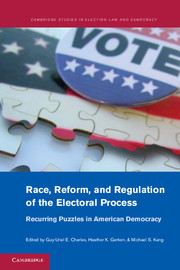Book contents
- Frontmatter
- Contents
- Figures
- Tables
- Contributors
- Preface
- Introduction: The Future of Elections Scholarship
- PART I RACE AND POLITICS
- PART II COURTS AND THE REGULATION OF THE ELECTORAL PROCESS
- PART III ELECTION PERFORMANCE AND REFORM
- Overview: Election Reform
- 8 New Directions in the Study of Voter Mobilization
- 9 Popular Election Monitoring
- 10 Democracy in the United States, 2020 and Beyond
- 11 Partisanship, Public Opinion, and Redistricting
- PART IV CONCLUSION
- Index
9 - Popular Election Monitoring
How Technology Can Enable Citizen Participation in Election Administration
Published online by Cambridge University Press: 01 June 2011
- Frontmatter
- Contents
- Figures
- Tables
- Contributors
- Preface
- Introduction: The Future of Elections Scholarship
- PART I RACE AND POLITICS
- PART II COURTS AND THE REGULATION OF THE ELECTORAL PROCESS
- PART III ELECTION PERFORMANCE AND REFORM
- Overview: Election Reform
- 8 New Directions in the Study of Voter Mobilization
- 9 Popular Election Monitoring
- 10 Democracy in the United States, 2020 and Beyond
- 11 Partisanship, Public Opinion, and Redistricting
- PART IV CONCLUSION
- Index
Summary
INTRODUCTION
In just the past few years, “crowd sourcing” – highly decentralized monitoring and information processing – has emerged as an important technique. Private sector and civic entrepreneurs have developed numerous Internet-based platforms to elicit information and utilize those data to construct knowledge that would otherwise be more costly or less trustworthy. Wikipedia, “a free encyclopedia that anyone can edit,” is perhaps the most prominent of these efforts. Similar approaches are used to produce reviews and ratings of books, movies, hotels, disease, and many consumer products.
Crowd-sourcing approaches have also been applied to develop knowledge in the natural and medical sciences. In ornithology, for example, the 2009 State of the Birds reports the status of bird populations in the United States based on professional monitoring databases and tens of thousands of “citizen-scientists” who file their own observations. Google has developed an algorithm to track patterns of influenza infection all over the world based on analysis of Internet users' search behavior. For the United States, Google Flu Trends indicators track flu indicators produced by the Centers for Disease Control and Prevention (CDC) very closely. Google results have the advantage of being available two weeks before CDC data.
Though policy makers and social scientists have been slower to exploit the possibilities of crowd-sourced monitoring, several innovations have emerged. A nongovernmental organization called Ushahidi, for example, has developed a crowd-sourced crisis reporting system that has been used to track incidents of post-election violence in Kenya, violence in the Gaza Strip, and most recently highly localized needs in the 2010 Haiti earthquake.
- Type
- Chapter
- Information
- Race, Reform, and Regulation of the Electoral ProcessRecurring Puzzles in American Democracy, pp. 192 - 208Publisher: Cambridge University PressPrint publication year: 2011
- 5
- Cited by



